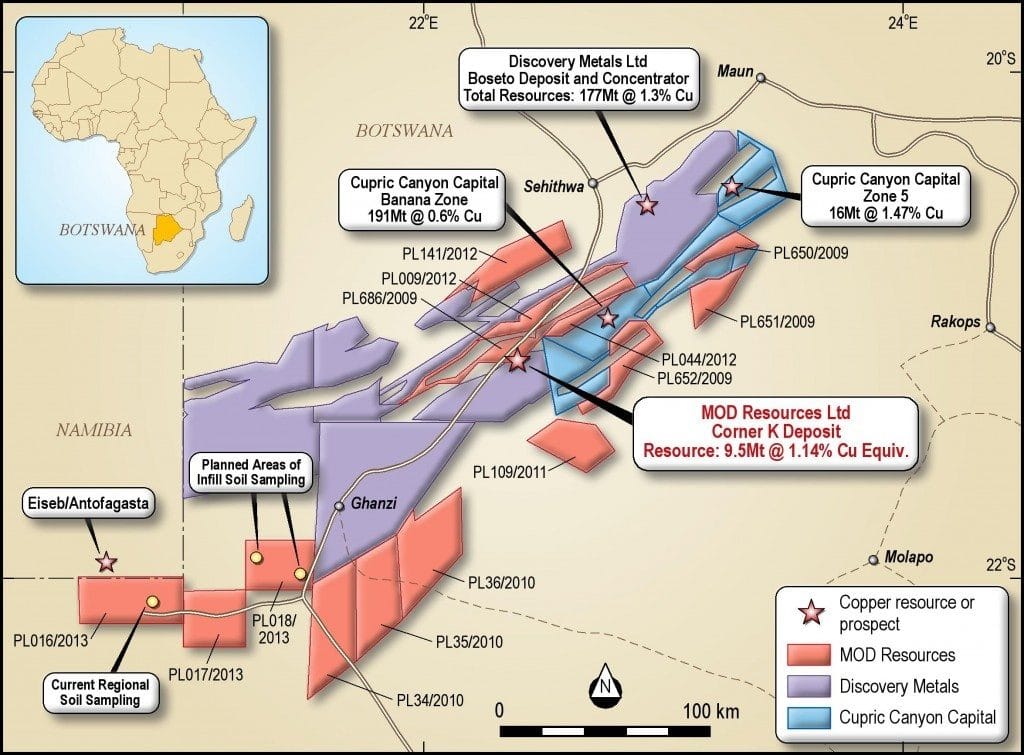WA Companies Leading Charge in Kalahari Copper Belt

There is something quite interesting going on in Africa at the moment, with a flurry of corporate activity this week centred around the lucrative but as yet relatively underexplored Kalahari copper belt that straddles Botswana and Namibia in the south of Africa – and Western Australian companies are leading the corporate charge.
Copper miner Sandfire Resources has revealed that, after a long period of due diligence, it would fully acquire fellow ASX-listed, Perth-based and Botswana focussed copper company, MOD Resources, in a cash and scrip deal worth $167m.
MOD controls the impressive T3 copper project in the heart of the Kalahari copper belt, which has a global mineral resource of 60.1 million tonnes grading about 1% copper and 14g/t silver for 590,000 tonnes of contained copper and nearly 27 million ounces of silver.
The company released a feasibility study in March outlining a robust, long-life, open pit mining and processing operation for T3, for an 11.5-year initial mine life.
That scenario showed a base case production of 3 million tonnes per annum, producing a life of mine average annual production of 28,000 tonnes of copper and 1.1 million ounces of silver.
MOD estimates it will turn out a pre-tax net profit of around USD$368m at a pre-tax internal rate of return of 33%.
The project has an all-in sustaining cost of USD$1.56 per pound copper, taking account of the silver credits and with a long-term projected price of USD$3.08 per pound, produces good margins and a four-year payback period.
Based on those metrics, T3 was not going to sit on the shelf for very long and Sandfire has now wrapped its hands around the compelling project, which still has significant exploration upside.
Sandfire has been hunting high and low for the right project to replace its highly profitable DeGrussa and Monty copper-gold deposits in WA when they are exhausted in the near future.
MOD expects the first production from T3 in 2021, so the timing for Sandfire could not be much better.
Also this week, ASX-listed and Perth-based diversified mining services provider Ausdrill Limited said that its subsidiary, Barminco, had been awarded a five-year underground mining services contract at Cupric Canyon Capital’s Zone 5 copper mine in Botswana.
That contract is worth an astounding AUD$800m to Barminco over the five years.
Cupric Canyon’s flagship high-grade Zone 5 mine is a fine piece of art holding a total mineral resource of 91.7 million tonnes grading an exceptional 2.1% copper and 22g/t silver with substantial regional targets.
The company said that its Zone 5 deposit discovery redefined the latent prospectivity of the Kalahari copper belt and rated Botswana as a stable and pro-mining jurisdiction for doing business.
The common denominator running through these recent transactions is the significant exploration success for copper achieved by both MOD and Cupric Canyon in the emerging Kalahari copper geological belt which is starting to attract substantial global interest now including from other ASX listed companies.
Interestingly the largest landholder in the lucrative Kalahari is not a large cap, but rather it is a small cap WA-based copper explorer known as Kopore Metals.
Kopore now controls more than 15,000 square kilometres of ground holdings at the southwestern end of the Kalahari copper belt where it melds from Botswana into Namibia.
The company’s tenements are contiguous with the MOD’s land holdings too and lie across the same regional structures and geological settings as MOD.
Kopore isn’t just land banking either with the rods now spinning as we go to print in both Botswana and Namibia only 150km from MOD’s T3 project.
Kopore’s land holdings in the Kalahari belt are virtually untouched and the company has used a combination of geophysics and geochemistry to delineate drill targets near sedimentary domal structures in both countries where it operates.
It has already intersected encouraging iron and copper sulphide mineralisation at the lower D’Kar formation, which is known to host economic accumulations of copper-silver mineralisation elsewhere in the Kalahari.
If you want to go elephant hunting, you need to go to elephant country and with several significant discoveries already unearthed on the Kalahari belt, Kopore certainly seems to have entered elephant country.
Just how many more elephants are lurking out there remains to be seen.
Source: The West Australian, 25 June 2019
